The Clone Wars: Season Five In Review: Part One
After Season Four of The Clone Wars ended last spring, Lex, Megan, and I wrote our four–part round–robin Season In Review. We had so much fun, we’re back for another round-robin for Season Five. Like last time, we’ll revisit the five arcs that comprised the season, and discuss the strengths and weaknesses, fun moments and moving scenes, with an emphasis on the story design, characterization, and storytelling techniques.
Although the season began with the episode “Revival,” we’ll discuss that next time along with the other three Darth Maul episodes. We’ll kick things off with the Onderon and Young Jedi arcs.
These two arcs showed Ahsoka’s increasing maturity as a young woman. Despite some difficult challenges, she also proved her commitment to doing her Jedi duty. What were some of your favorite Ahsoka moments from these arcs?
Tricia: The Onderon arc tested Ahsoka with feelings of attachment to something outside the Jedi Order, which was the very thing that caused her Master’s fall later. Like many young women at a similar age, she is unsure what those feelings mean – if they’re romantic or strong bonds of friendship. She doesn’t get a chance to stop and really think about it. There is something of a revelation of her strength of character that she can rein in her emotion. It’s bittersweet to see Anakin empathize and support her as a mentor, and then to know he won’t be able to move past his attachments.
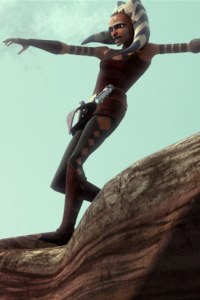 In the Young Jedi arc, we finally saw Ahsoka begin to mentor younger Jedi. I believe the term I used on the Clone Wars Roundtable was that she was the “camp counselor.” This is sort of a natural part of the process. The Order wouldn’t just give a Jedi an apprentice, but also teach them how to train the younglings coming up behind the Padawans. So this was her first chance to be the responsible one in charge.
In the Young Jedi arc, we finally saw Ahsoka begin to mentor younger Jedi. I believe the term I used on the Clone Wars Roundtable was that she was the “camp counselor.” This is sort of a natural part of the process. The Order wouldn’t just give a Jedi an apprentice, but also teach them how to train the younglings coming up behind the Padawans. So this was her first chance to be the responsible one in charge.
Lex: I particularly liked two moments in the Young Jedi arc. When the pirates attacked the Jedi ship, Ahsoka did exactly what she was supposed to do: secure the younglings’ safety, then take action to get the pirates off the ship. She risked her own life with the airlock ploy, and ended up captive of the pirates in the process. This is exactly how a Jedi Knight should act in that situation; I could easily imagine Obi-Wan or Mace handling the situation the same way. (Anakin too, unless his anger got the better of him.)
I also really liked the ending of her fight with Grievous on Florrum. Instead of trying too hard to take him down herself, and likely getting herself killed, she made the right choice and Force-jumped up to Slave I to escape with the younglings and Hondo. Again, exactly how a Jedi Knight should act in that situation.
Megan: I liked how Ahsoka recognized each of the younglings’ particular skill sets, for example telling the tech-savvy Zatt and Ganodi to start up the ship in order to escape the pirates. Her duel with Grievous was impressive too: it was interesting to compare how Ahsoka fought the droid leader with Obi-Wan’s fight with him in Revenge of the Sith.
Likewise a lot of my favorite Ahsoka moments in the Onderon arc are fight scenes: her limber skill with her two lightsabers, or how she stalks over rooftops. I didn’t feel she got enough emotional closure in that arc, but she demonstrated her prowess as a Jedi.
Even though he was barely present, Anakin had profound influence on these arcs. Do you think Anakin’s training had a positive or negative effect on Ahsoka’s development overall?
Tricia: Ahsoka’s flaws are very much Anakin’s flaws. The difference is she was trained from a young age, as opposed to Anakin who started training after living as a slave. Even in the last arc of the season, Anakin tells Ahsoka he fights because there are good people in the Jedi Order – obviously he extends that “good” label to Padmé and Palpatine. He doesn’t fight for the will of the Force or some greater good. Ahsoka knows she’s fighting for something bigger than herself, or even her friends like Lux, Steela, and Saw. She doesn’t even stay in the Jedi Order because that would be best for Anakin. Still, it was Anakin who counseled her on attachments while on Onderon and gave her the strength to move past them.
 Ahsoka is also as impulsive and defiant as her master, but these aren’t weaknesses when a Jedi is under attack. On both Onderon and in the Young Jedi arc, Ahsoka’s bold strategies work.
Ahsoka is also as impulsive and defiant as her master, but these aren’t weaknesses when a Jedi is under attack. On both Onderon and in the Young Jedi arc, Ahsoka’s bold strategies work.
Lex: She definitely picked up some of his recklessness, and willingness to try crazy plans now rather than retreat and try again later. Much like Anakin, she had to be convinced to pursue more cautious strategies on Onderon instead of going aggressive from the start. Her tactic for liberating the Jedi ship from the pirates was worthy of a crazy Anakin plan, too.
On Onderon we also see that Ahsoka has some of Anakin’s disobedient streak. She generally follows her orders from the Council, but she goes off script several times, as well. I like to think of this as Qui-Gon’s influence. In The Phantom Menace, young Obi-Wan tells his Master that he would be on the Council if he would just follow instructions. Anakin emulates Qui-Gon in that way, and we see some of that rubbing off on Ahsoka, too. So maybe that’s not such a bad thing.
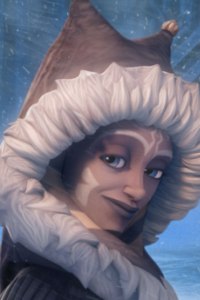 Megan: I definitely agree that Ahsoka picked up a lot of Anakin’s traits. I wonder if she would have calmed down if she were the pupil of a different Jedi (maybe Plo Koon?) or if, like in the case of Obi-Wan training Anakin, a calm teacher would have just made her more rebellious. She clearly respects Anakin but doesn’t hero-worship anyone, and a lot of her traits in season five are the same as, not in spite of, the pluckiness she showed way back in The Clone Wars movie. Ahsoka is such an independent spirit that it seems likely that she’d have kept a lot of the same traits no matter who her Master was.
Megan: I definitely agree that Ahsoka picked up a lot of Anakin’s traits. I wonder if she would have calmed down if she were the pupil of a different Jedi (maybe Plo Koon?) or if, like in the case of Obi-Wan training Anakin, a calm teacher would have just made her more rebellious. She clearly respects Anakin but doesn’t hero-worship anyone, and a lot of her traits in season five are the same as, not in spite of, the pluckiness she showed way back in The Clone Wars movie. Ahsoka is such an independent spirit that it seems likely that she’d have kept a lot of the same traits no matter who her Master was.
She was never disloyal to the Jedi until the end, but when she is, she even goes against Anakin himself. I think he was a positive influence in many ways, but in the long run she was better than him: she could balance loving and caring for people against her desire to possess and control them, which is exactly what Anakin couldn’t do.
Finally, we can’t talk about Ahsoka’s role in these arcs without mentioning the season-ending arc. How does knowing what choices she makes later affect how you view her actions in these two stories?
Tricia: Ultimately, we’re seeing who Anakin could have been, if he had been trained from a young age. While Ahsoka’s reactions upon being framed seem very teenage-like, everything started to snowball. She had gained a lot of self-confidence in her ability to make a call in the heat of the moment, and also that her perspective on the world was opening up. By teaching and leading, her understanding of the war and the dynamics were clicking into place. I don’t believe she had put all the pieces together, but something deep inside knew the system was broken. Steela’s death is a reminder that people with the best of intentions are the ones the bad guys want to knock out first.
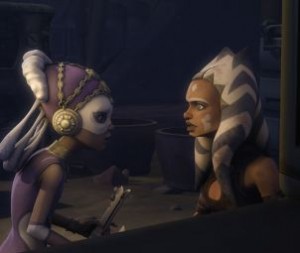 Lex: In retrospect, these two arcs definitely were putting elements of her characterization in play that they were going to cash in during the finale arc. On Onderon, we see Ahsoka’s growing confidence in her own judgment, rather than simply doing what’s expected of her. She also gets a lesson in the impotence of the Jedi and the Republic in the face of political difficulties. In the Young Jedi arc, she has a chance to relearn the idea that the Force touches each Jedi in an individual way, and something that might be right for one Jedi might be wrong for another. That reminder played a role in her realization that she had to walk away from the Order, no matter how much Anakin wanted her to stay. In her captivity by the pirates, she also was reminded that doing the right thing sometimes means you end up suffering at the hands of less savory individuals.
Lex: In retrospect, these two arcs definitely were putting elements of her characterization in play that they were going to cash in during the finale arc. On Onderon, we see Ahsoka’s growing confidence in her own judgment, rather than simply doing what’s expected of her. She also gets a lesson in the impotence of the Jedi and the Republic in the face of political difficulties. In the Young Jedi arc, she has a chance to relearn the idea that the Force touches each Jedi in an individual way, and something that might be right for one Jedi might be wrong for another. That reminder played a role in her realization that she had to walk away from the Order, no matter how much Anakin wanted her to stay. In her captivity by the pirates, she also was reminded that doing the right thing sometimes means you end up suffering at the hands of less savory individuals.
Megan: Her captivity and the fact that the younglings had to save her also might have contributed for her desire to take things into her own hands in the final arc. Both Onderon and Florrum also introduced her to working with people she normally wouldn’t – younglings and rebels, which weren’t quite as extreme as her eventually working with Asajj Ventress. Both are bittersweet arcs because you can see Ahsoka looking both backward and forward, such as when she talks about her lightsaber. She’s considering what she was like as a youngling herself, and then on Onderon she talks to Anakin as one adult to another. They’re like the two halves of the Jedi life she eventually leaves.
It’s also possible to read Ahsoka’s conversation about attachment in the Onderon arc as her figuring out Anakin’s relationship with Padmé, and then their parting words in the final arc as her telling him that she knows. I also really liked that “The Gathering” contains some of Ahsoka’s more incidental dialogue that makes her really seem like a Jedi Knight and a teacher. It’s obvious that the last five seasons have all lead up to her having those abilities and being in that place.
In addition to Ahsoka, these stories featured a number of other female characters, such as Steela on Onderon and the Jedi youngling Katooni. Who was your favorite?
Tricia: I’d have to go with Katooni. She had an earnest, hopeful quality that reminded me of Luke, but also a natural ability to rally her peers and even bend Hondo’s self-serving motivations. For the kids, it was nice to see a character struggle with creating her lightsaber. The best lightsaber builders weren’t always the best at other aspects of being a Jedi.
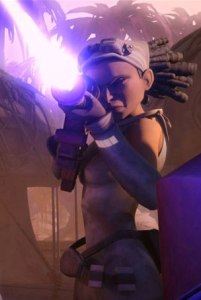 Lex: Steela was a great character. She was a natural leader, but didn’t realize it until others made her see it in herself. I also really liked her interactions with Saw; it was very real brother-sister dynamic, with both rivalry and loyalty elements deeply embedded in their interactions. I thought it was a nice touch that the other rebels rallied around her so readily. It would have been easy to include a male character expressing doubt in her ability to lead simply because she was a woman, and I’m glad The Clone Wars skipped right past that cliché. And while I do understand that the rebels needed to make a sacrifice to retake their planet, and that Steela’s death probably carried the biggest possible impact, I still think it’s unfortunate that Steela got killed off. It would have been nice to keep another great female character around for future use in stories.
Lex: Steela was a great character. She was a natural leader, but didn’t realize it until others made her see it in herself. I also really liked her interactions with Saw; it was very real brother-sister dynamic, with both rivalry and loyalty elements deeply embedded in their interactions. I thought it was a nice touch that the other rebels rallied around her so readily. It would have been easy to include a male character expressing doubt in her ability to lead simply because she was a woman, and I’m glad The Clone Wars skipped right past that cliché. And while I do understand that the rebels needed to make a sacrifice to retake their planet, and that Steela’s death probably carried the biggest possible impact, I still think it’s unfortunate that Steela got killed off. It would have been nice to keep another great female character around for future use in stories.
Megan: I loved Katooni. Her voice actor conveyed a lot while still sounding like a kid, she wasn’t precocious or annoying, and she had a satisfying arc with her trouble building her lightsaber and then the unconventional encouragement she received from Hondo. I’m glad her lesson took center stage a little bit more than Petro’s.
I also can’t forget Dono, the rebel messenger who only gets a little bit of screen time but shows that there are young women in the rank-and-file of the rebel army too.
He may not be a female character, but Hondo Ohnaka practically stole the show. We saw some more depth to his character, too. What did you like best about Hondo’s appearances in these two arcs?
Tricia: Hondo is like the Jack Sparrow of Star Wars. You can’t not love him. He’s in that spectrum where Han and Lando started – in it for themselves, but every once in a while showing that they have a soft spot. Every character doesn’t need to be pulled over to the “good” side, but he’s fun because he’s unpredictable.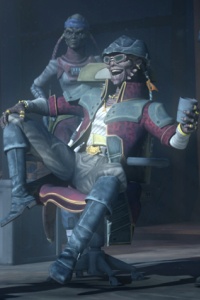
Lex: Hands down, Hondo was given some of the best dialogue in the entire season. “I am semi-speechless” is now in my list of all-time favorite Star Wars lines from any story in any medium. I also really enjoy how he enjoys taunting the Jedi when they make moral compromises, like when Anakin came to negotiate for the rocket launchers for the Onderon rebel and when Ahsoka questioned his motives when they rescued her during Grievous’ attack on Hondo’s base. But I think my favorite scene was when he rattled off his list of charges on the bill he claimed he’d sent Obi-Wan for his “rescue” services for Ahsoka and the younglings. “Some of them died, I think.”
Megan: I would even go so far to say, despite recent This is Madness score results, that Hondo is more entertaining than Han or Lando. The fact that he’s an alien helps sway my personal opinion, but he’s also so energetically, unapologetically amoral. I regularly quote “I am semi-speechless.” Hondo’s got his own standards of honesty and hospitality, but they change by the day and he knows that. He’s funny, but also dangerous and unpredictable enough that he didn’t feel like a pastiche of a villain in the Young Jedi arc. He also serves to recap past episodes or to explain things, since the Force and the Sith are unknowns to him, but those lines always feel organic to him and it’s nice to have such an aware character.
The Young Jedi arc may have featured younglings, but it actually revealed a great deal about the teachings of the Jedi and their relationship with the Force. What surprised you the most?
Tricia: These episodes included much more of a spiritual element than we’re used to seeing. The mysticism of Star Wars has always been there, but it’s often just taken for granted or overshadowed by lightsaber duels and cool spaceships. The Jedi are wizards in a space opera, and this arc reminded me of some of the classic tales where the wizard or sorceress initiate went on a quest to reach beyond the limitations of the mortal realm and tap the powers that make him or her different.
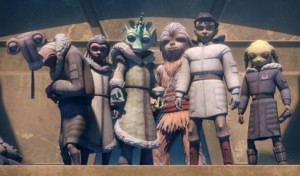 Lex: The Ilum temple with the crystals was another version of the “only what you take with you” lesson from the Dagobah cave in The Empire Strikes Back. It was a cool way to introduce the idea to young people, both in-universe Jedi and out-of-universe television viewers. But the level of detail we got to see in how Jedi build their lightsabers was definitely surprising. Although the Expanded Universe has addressed this before, and we caught a glimpse of it in the Ilum episodes of the Tartakovsky micro-series, I thought George Lucas might keep his vision of lightsaber construction close to the vest. I’m glad he shared it with us in The Clone Wars, though.
Lex: The Ilum temple with the crystals was another version of the “only what you take with you” lesson from the Dagobah cave in The Empire Strikes Back. It was a cool way to introduce the idea to young people, both in-universe Jedi and out-of-universe television viewers. But the level of detail we got to see in how Jedi build their lightsabers was definitely surprising. Although the Expanded Universe has addressed this before, and we caught a glimpse of it in the Ilum episodes of the Tartakovsky micro-series, I thought George Lucas might keep his vision of lightsaber construction close to the vest. I’m glad he shared it with us in The Clone Wars, though.
Megan: It also revealed a lot about Yoda. The fact that the threat of the ice cave closing up was all a trick surprised me, and matched the original trilogy Yoda so well. I agree with Lex that it was nice to see a fleshed-out version of lightsaber construction that could, with a little finagling, fit right into canon beside the Tartakovsky version. It seems that caves of the dark side – or at least the trickster side of the Force – aren’t restricted to Dagobah. Something in there knew exactly what each youngling needed to learn.
Check back soon for Part Two, when we’ll discuss the D-Squad and Maul arcs from Season Five.
- Hyperspace Theories: Bad Luck Ghorman - June 2, 2025
- Hyperspace Theories: One Year Later as ANDOR Kicks Off Season Two - May 15, 2025
- REVIEW: Tales of the Underworld - May 4, 2025









